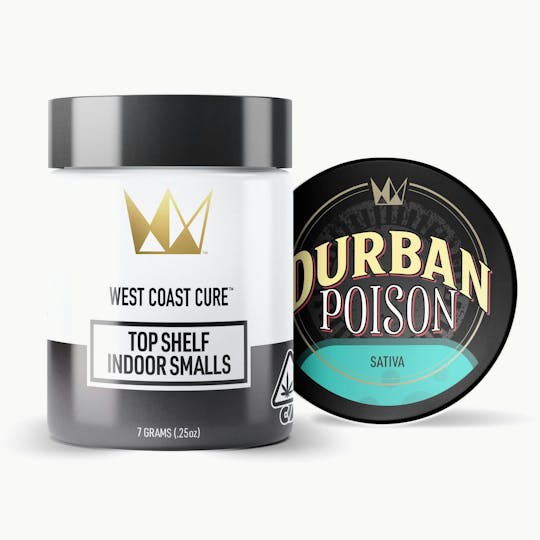
Durban Poison - 7G Top Shelf Indoor Smalls
Durban Poison Top Shelf Flower is a petrol-packed Sativa with an earth and spice aroma and uplifting effects. A legacy strain in the cannabis community, this tight and conical-shaped flower boasts a complex terpene profile that releases an energized scent of diesel and earth. The strain's effect is breezy and creative, providing a mental pathway to a relaxed mindset.
- Earthy
- Woody
- Spicy/Herbal
West Coast Cure brings years of connoisseur cannabis mastery to the table, effortlessly offering consumers the best marijuana experience. With an award-winning pedigree and that extra something special, West Coast Cure is the go-to cannabis label for the true connoisseur. It’s not something West Coast Cure works at; they simply have a Passion for Cannabis.
Durban Poison has deep roots in the Sativa landrace gene pool. The strain’s historic phenotypes were first noticed in the late 1970s by one of America’s first International strain hunters, Ed Rosenthal. According to cultivation legend, Rosenthal was in South Africa in search of new genetics and ran across a fast flowering strain in the port city of Durban. After arriving home in the U.S., Rosenthal conducted his own selective breeding process on his recently imported seeds, then begin sharing. Rosenthal gave Mel Frank some of his new South African seeds, and the rest was cannabis history.
Frank, who wrote the “Marijuana Grower’s Guide Deluxe" in 1978, modified the gene pool to increase resin content and decrease the flowering time. In search of a short-season varietal that could hit full maturation on the U.S. East Coast, Frank’s crossbreeding efforts resulted in two distinct phenotypes, the “A” line and “B” line. The plant from Frank’s “A” line became today’s Durban Poison, while the “B” line was handed off to Amsterdam breeder David Watson, also known as “Sam the Skunkman.”
Durban Poison has a dense, compact bud structure that’s typical of landrace Indica varieties, but the flowers’ elongated and conical shape is more characteristic of a Sativa.

